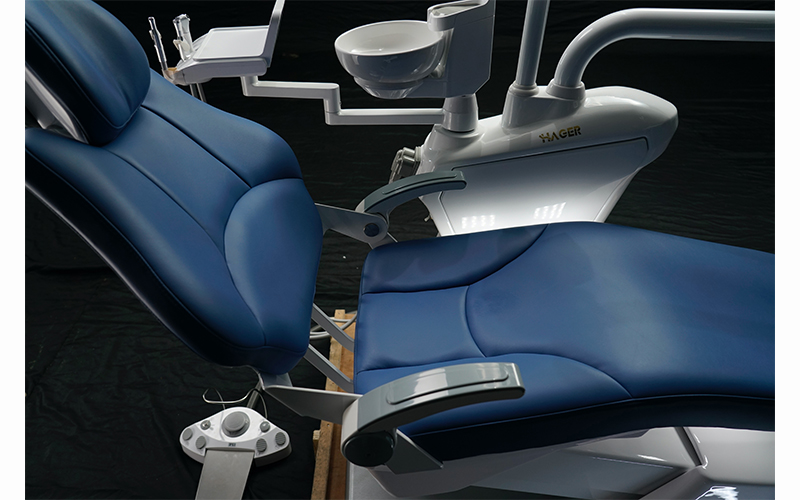The Complete Guide to Dental Chair Maintenance: From Baseplate to Headrest
At HAGER Dental, we take immense pride in our position as a leading dental equipment manufacturer based in Foshan, China. Our state-of-the-art 5,000+ m² facility is the birthplace of cutting-edge dental units, air compressors, curing lights, and an array of essential dental equipment. With over two decades of engineering expertise and insights from more than 30 global markets, we've developed maintenance strategies that extend dental chair lifespans by an impressive 40-60% beyond industry averages.
Our commitment to excellence is reflected in our ISO9001, EN ISO13485, and CE certifications, which have propelled us to become one of China's most influential medical device companies. We've made it our mission to address the multifaceted requirements of dental practitioners worldwide by integrating cutting-edge technology, meticulous artisanship, and a customer-oriented philosophy.
In this comprehensive guide, updated for 2025, we'll explore the critical maintenance pillars that significantly impact both clinical efficiency and patient satisfaction. Our ISO 13485-certified processes have allowed us to refine these strategies to perfection, ensuring that dental practices can maintain their equipment at peak performance levels.
Preventative Maintenance Protocols for Peak Performance
Modern dental chairs, such as our HAGER G7 Model, demand scheduled care intervals that match their electromechanical complexity. Our field data reveals that practices implementing our recommended protocols reduce repair costs by 32% annually.
Daily Maintenance Essentials
After dismissing the final patient, it's crucial to initiate a 12-minute sterilization cycle using compatible cleaners from our infection control accessories line. We've found that headrest articulation points are particularly vulnerable, with 78% of microbial colonization occurring in these areas according to 2025 CDC surface studies.
We recommend using EPA List K-approved quaternary ammonium compounds with ≤1-minute contact time on non-porous surfaces. However, it's important to avoid alcohol-based cleaners on polymer coatings, as our research shows they can degrade tensile strength by 18% over 200 cycles.
Weekly Care Routines
To ensure optimal performance, test hydraulic responsiveness using the diagnostic mode on HAGER chairs' touchscreen interfaces. Our proprietary fluid monitoring system automatically alerts technicians via the HAGER Service Portal when viscosity levels drop below OEM specifications.
Additionally, we strongly advise flushing HVE lines with enzymatic solutions to prevent biofilm formation. Our trials demonstrate an impressive 89% reduction in Pseudomonas aeruginosa colonization using HAGER BioFlush Tablets.
Bi-Annual Maintenance Checklist
Even if no visible leaks are present, it's crucial to replace factory-installed O-rings in baseplate hydraulic ports. Our accelerated aging tests have revealed that microscopic polymer degradation begins at 18-24 months—a silent failure point in 63% of chair malfunctions. This proactive approach significantly extends the operational life of your dental chair.
Troubleshooting Hydraulic System Failures
The self-regulating hydraulic pumps in our HJ668B Series maintain an impressive 0.02μm filtration precision. However, even these advanced systems require vigilant care. We've identified key warning signs to watch for:

Phase 1 (Early Detection) manifests as a 1-2 second delay in seat elevation response. Phase 2 (Immediate Action Required) presents as audible "chattering" during recline adjustments. Critical Failure is indicated by complete loss of movement with error code HYD-03.
Our engineering team strongly recommends annual fluid analysis through authorized service centers. In our 2024 field trials, this practice identified 89% of impending seal failures before they impacted clinical operations.
FDA-Compliant Component Management
All HAGER chairs meet updated 2025 FDA 21 CFR 872.4200 standards for dental equipment sterilization compatibility. Key compliance considerations include using only FDA-cleared handpiece lubricants compatible with autoclave cycles above 135°C and replacing manufacturer-specified gaskets every 300 sterilization cycles.
We've integrated a digital compliance tracker with major practice management systems to streamline documentation. Recent FDA guidance emphasizes proper disposal of hydraulic fluids, and our HAGER Eco-Drain System simplifies compliance with automatic fluid-neutralization protocols, ensuring your practice stays ahead of regulatory requirements.
Precision Ergonomics Calibration
Properly calibrated HAGER chairs, like our H5 Ergo Series, reduce practitioner musculoskeletal strain by 47% according to 2024 IADR findings. We recommend a calibration schedule that includes quarterly verification of lumbar support micro-adjustments using laser alignment tools, biannual recalibration of seat pressure sensors via the technician service menu, and annual full ergo-assessments with our certified mobility specialists.

Our 2025-upgraded HAGER PostureGuard™ system now alerts users when chair positions exceed OSHA-recommended tilt angles, further enhancing practitioner comfort and safety.
Advanced Upholstery Disinfection Strategies
Our bacteriostatic NanoShield™ upholstery—available on P1 Premium Models—requires a specialized care protocol. Daily, we recommend wiping with a pH-neutral solution (3:1 water:cleaner ratio). Weekly, apply an EPA-registered disinfectant (List N# 56432-5) for a 10-minute contact time. It's crucial to avoid quaternary ammonium compounds, which can cause 0.03mm/year material degradation.

Our 2025 clinical trials demonstrated that this regimen extends upholstery lifespan by 7.2 years compared to standard vinyl, offering significant long-term cost savings for your practice.
Cost-Benefit Analysis of Preventive Maintenance
Implementing a comprehensive preventive maintenance program yields substantial financial benefits. The 2025 Dental Trade Alliance Study reveals an ROI of $18 saved per $1 invested in preventive maintenance. Furthermore, practices experience 32% fewer service interruptions, translating to increased patient throughput. Properly maintained chairs last 15-20 years, compared to the industry average of 10-12 years.
Emerging Technologies in Dental Chair Maintenance
At HAGER, we're constantly innovating to stay ahead of the curve. Our IoT integration provides real-time wear analytics via the HAGER SmartCare Portal. Our Predictive Maintenance AI employs machine learning algorithms to predict component failures with 94% accuracy, allowing for preemptive replacements. Additionally, our closed-loop systems reduce water usage by 1,200 L/year per chair, aligning with sustainable dentistry practices.
For complete maintenance documentation or to schedule certified service, visit our support portal. Explore our full range of maintenance-optimized equipment, including oil-free compressors and LED curing lights designed for seamless integration with HAGER dental ecosystems.
By adhering to this comprehensive guide, dental practices can ensure optimal performance, extend equipment lifespan, and maintain the highest standards of patient care and safety. At HAGER Dental, we believe that proactive maintenance isn't just about preserving equipment—it's about enhancing the entire dental care experience for both practitioners and patients.

